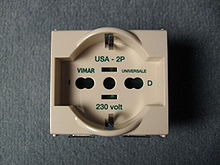Connector type L
A connector type L is a connector with three contact pins .
Structure, voltage and current
There are two variants of the connector system. Both variants have two round contact pins for the outer conductor and the neutral conductor , the shaft of which is insulated. In the middle is another, equally long, but not insulated contact pin for the protective conductor . A protective collar around the socket is not provided. Couplings on extension cables and connector strips are therefore protected against single-pole insertion of plugs by mechanical protection. The system is usually provided with 220-230 V AC voltage used, 50 Hertz.
10 amp plug
In variant 1, the distance between the outer pins is 19 mm, the earthing pin is in the middle. The pens are 4.5 mm thick. The outer pins have contact protection. The maximum current for variant 1 is 10 A. The Euro plug was designed so that it fits into sockets of variant 1.
16 amp plug
Variant 2 is designed for currents up to 16 A and is characterized by 5.1 mm thick contact pins, but the distance between the outer pins is 26 mm (approx. 1 inch). This means that the two variants are incompatible with each other. The ground pin is again between the conductive pins.
compatibility
Sockets for 10 amperes can accept Euro plugs, but not contour plugs, Schuko plugs or type E plugs, as these have thicker pins.
Sockets for 16 amps cannot accept contour plugs , Schuko plugs or 2P + T plugs (plug type E) - although the pin thickness is correct, the distance is too large.
Gost 7396 plugs with thinner contact pins also fit in sockets for 10 amperes . In these cases, however, the protective conductor function is no longer given, so that this use represents a safety risk. In this case, an adapter plug must be used correctly.
In addition to type L plugs (10 A and 16 A), newer sockets can also accept Schuko plugs and various other plugs.
safety
Reverse polarity protection
Type L plugs are not reverse polarity protected . This means that when plugs are connected, the position of the outer conductor and the neutral conductor is not fixed, which can lead to safety risks for certain consumers. For example, it can happen that the outer conductor is connected to the easier-to-touch screw socket instead of the base of an incandescent lamp.
Finger security
Protective collars around sockets are not provided. Finger safety is achieved in that the contact pins are generally provided with an insulated shaft.
The single-pole insertion of plugs into couplings is - provided the construction of the coupling does not make this impossible anyway - prevented by protective flaps that only open when a pin is inserted into both openings.
Leading protective conductor
A leading protective conductor that comes into contact with the live conductors when plugged in is theoretically possible by arranging the contact springs accordingly, but is not expressly provided for by the standard and consequently not implemented everywhere.
Mechanical properties
Due to the slim design of the plug, the comparatively great depth and the lack of a protective collar, a secure hold of the plug in the socket is not always guaranteed, especially with variant 1. Although the finger-safe construction of the plug prevents accidental contact with live parts, perfect contact cannot be guaranteed, especially with worn out sockets.
Electrical load capacity
Fine fuses in the plugs are not provided, so that the only protection against electrical overload of plug connections is the fuse of the house installation.
In combination sockets that can accommodate version 1 (10 A) and version 2 (16 A), both contacts are usually switched in parallel so that separate protection for 10 A and 16 A is not possible.
Child safety
Couplings on extension cables and connector strips are equipped with protective devices, which are mainly intended to prevent single-pole insertion of plugs, but also offer protection against the insertion of objects into a single opening. Wall sockets often lacked this device in the past, but newer wall sockets also have this protection.
compatibility
Many connector systems have been developed with the aim of being incompatible with all other systems (and mostly viewed as unsafe by the developers of the new system); real protection cannot be achieved this way. The industry often answers such incompatibilities with solutions that - inevitably or potentially - are even more insecure than the "old" system.
In the case of the L type, Gost 7396 plugs , which are mainly found in Eastern Europe and Spain, as well as some plugs of the French 2P + T system can be inserted into couplings intended for plugs of variant 1. The live contacts are connected so that a connected device works, but not the protective conductor.
distribution
- Italy ; Schuko sockets are particularly common in South Tyrol (especially in new installations)
- Greece ; earlier in addition to the Schuko sockets
- Albania ;
- Individual countries in Africa and South America , but not exclusively there
- In the Canary Islands



